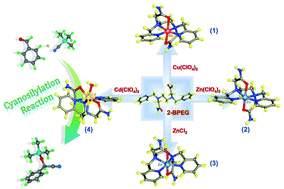Novel primary amide-based cationic metal complexes: green synthesis, crystal structures, Hirshfeld surface analysis and solvent-free cyanosilylation reaction†
Abstract
A new symmetrical and flexible primary amide functionalized ligand, 2,2′-(ethane-1,2-diylbis((pyridin-2-ylmethyl)azanediyl))diacetamide (2-BPEG), has been synthesized and structurally characterized. Using this multidentate ligand, four novel metal complexes, namely [Cu(2-BPEG)](ClO4)2·0.5H2O (1), [Zn(2-BPEG)](ClO4)2 (2), [Zn(2-BPEG)](ZnCl4)·H2O (3) and [Cd(2-BPEG)(H2O)](ClO4)2·H2O (4), have been synthesized under ambient conditions and characterized by elemental, spectroscopic and thermal analysis, and single and powder X-ray diffraction. Complexes 1–3 are hexacoordinated with an N4O2 donor set (provided by the hexadentate 2-BPEG ligand), while complex 4 is heptacoordinated with an additional coordinated water molecule. In all cases, the 2-BPEG ligand acts as a hexadentate ligand. A change in the starting metal salt has resulted in the formation of 2 and 3 with different tetrahedral anions, ClO4− and ZnCl4−, respectively. This has provided an opportunity to showcase anion-directed supramolecular networks for these compounds. Compounds 1, 2 and 4 with perchlorate anions show similar and comparable intermolecular interactions in their 3D networks. On the other hand, the supramolecular self-assembly of 3 is dominated by a variety of intermolecular interactions such as C–H⋯Cl, N–H⋯Cl, O–H⋯Cl and C–H⋯O due to the presence of a tetrachlorozincate(II) ion. Moreover, the role of weak intermolecular interactions in the crystal packing has been analysed and quantified using Hirshfeld surface analysis. Furthermore, compound 4 exhibiting an open Lewis acid site has been found to be a very efficient and recyclable heterogeneous catalyst for the solvent-free cyanosilylation of various aldehydes with trimethylsilyl cyanide (TMSCN) producing the corresponding trimethylsilyl ether in high yields.



 Please wait while we load your content...
Please wait while we load your content...